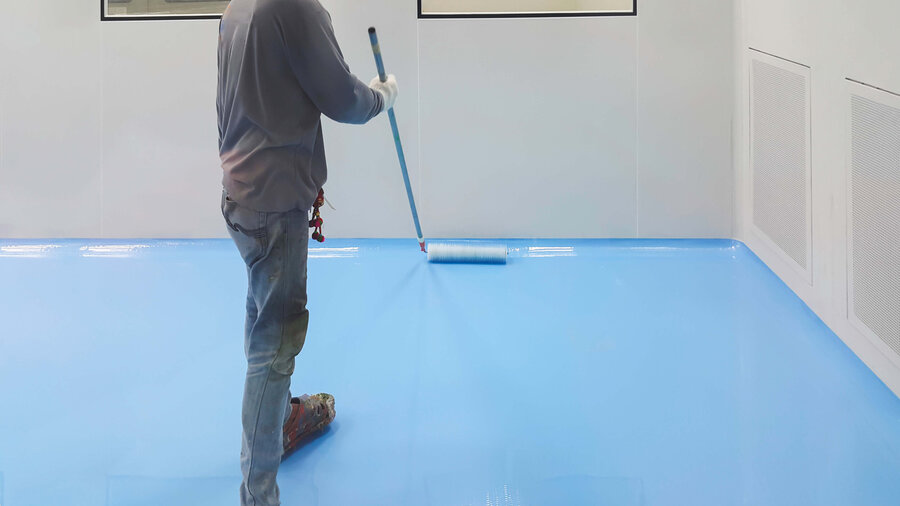Discovering the World of Anti-Slip Epoxy Floors

In the realm of flooring, where aesthetics often take center stage, there’s a growing trend that marries safety with style: anti-slip epoxy floors. These remarkable surfaces strike a harmonious balance between functionality and design, offering the assurance of traction without sacrificing visual appeal. In this comprehensive blog, we will explore the world of anti-slip epoxy floors, uncovering the many benefits they bring to spaces and how they elevate safety and elegance to new heights.
What Are Anti-Slip Epoxy Floors?
Anti-slip epoxy floors, also known as non-slip epoxy floors, are a specialized type of epoxy flooring that is designed to provide traction and prevent slips and falls. They are created by adding specific aggregates or additives to the epoxy resin during the installation process, which creates a textured surface that enhances grip, even in wet or oily conditions.
One of the standout features of anti-slip epoxy floors is their ability to combine safety with style. Here’s how they achieve this delicate balance:
Enhanced Traction: The primary purpose of anti-slip epoxy floors is to reduce the risk of accidents caused by slippery surfaces. The added texture improves traction, making them ideal for areas where spills or moisture are common, such as kitchens, bathrooms, or industrial settings.
Visual Appeal: Contrary to the perception that safety flooring compromises aesthetics, anti-slip epoxy floors are available in a wide range of colors and finishes. This allows them to seamlessly blend into various design schemes while providing the required safety features.
Customization: Anti-slip additives can be tailored to suit different levels of slip resistance. This means that you can choose the degree of slip resistance that suits your specific needs, whether it’s for a residential bathroom or a high-traffic commercial kitchen.
Benefits of Anti-Slip Epoxy Floors
The advantages of anti-slip epoxy floors extend beyond safety and aesthetics. Here are some key benefits:
Durability: Like traditional epoxy flooring, anti-slip epoxy floors are highly durable and can withstand heavy traffic, impact, and abrasions. This makes them suitable for both residential and commercial use.
Low Maintenance: They are easy to clean and maintain, typically requiring only regular sweeping and occasional mopping to keep them in top condition.
Chemical Resistance: Anti-slip epoxy floors are resistant to chemicals, oils, and stains, making them ideal for industrial or garage settings.
Longevity: With proper installation and maintenance, anti-slip epoxy floors can last for many years, making them a cost-effective flooring solution.
The installation of anti-slip epoxy floors involves a precise and systematic approach. Here’s a simplified overview of the steps involved:
Surface Preparation: The existing floor is thoroughly cleaned, repaired, and primed to ensure proper adhesion of the epoxy coating.
Epoxy Application: The epoxy resin, mixed with anti-slip additives, is applied to the prepared surface. The texture is determined by the type and amount of additives used.
Curing: Epoxy floors require time to cure and harden, usually taking a few days. During this period, the floor should not be subjected to heavy use.
Sealing: Once cured, the anti-slip epoxy floor is sealed to enhance its durability and appearance. The type of sealant used can also affect the final look of the floor.
Anti-slip epoxy floors are a testament to the evolving world of flooring, where safety and aesthetics coexist seamlessly. They offer a wealth of benefits, from enhanced traction to durability and low maintenance. Moreover, they are versatile, adapting to various design schemes and environments.
When choosing flooring for your space, consider anti-slip epoxy as a practical and stylish solution that ensures safety without compromising on elegance.
- Anti-slip epoxy floors offer enhanced traction in wet or oily conditions.
- They balance safety with aesthetics, available in various colors and finishes.
- Benefits include durability, low maintenance, chemical resistance, and longevity.
- Installation involves surface preparation, epoxy application, curing, and sealing.
